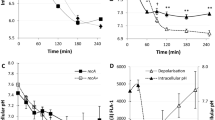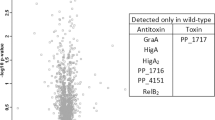Abstract
Chromate-hypersensitive mutants of the Pseudomonas aeruginosa PAO1 strain were isolated using transposon-insertion mutagenesis. Comparison of the nucleotide sequences of the regions interrupted in the mutants with the PAO1 genome revealed that the genes affected in three mutant strains were oprE (ORF PA0291), rmlA (ORF PA5163), and ftsK (ORF PA2615), respectively. A relationship of these genes with chromate tolerance has not been previously reported. No other phenotypic changes were observed in the oprE mutant but its resistance to chromate was not fully restored by expressing the ChrA protein, which extrudes chromate ions from the cytoplasm to the periplasmic space. These data suggest that OprE participates in the efflux of chromate from the periplasm to the outside. Increased susceptibility of the rmlA mutant to the metals cadmium and mercury and to the anion-superoxide generator paraquat suggests a protective role of LPS against chromate toxicity. A higher susceptibility of the ftsK mutant to compounds affecting DNA structure (ciprofloxacin, tellurite, mitomycin C) suggests a role of FtsK in the recombinational repair of DNA damage caused by chromate. In conclusion, the P. aeruginosa genome contains diverse genes related to its intrinsic resistance to chromate. Systems pertaining to the outer membrane (OprE), the cell wall (LPS), and the cytoplasm (FtsK) were identified in this work as involved in chromate protection mechanisms.




Similar content being viewed by others
References
Ackerley DF, Barak Y, Lynch S, Curtin J, Matin A (2006) Effect of chromate stress on Escherichia coli K-12. J Bacteriol 188:3371–3381
Begg KJ, Dewar SJ, Donachie WD (1995) A new Escherichia coli cell division gene, ftsK. J Bacteriol 177:6211–6222
Blankenfeldt W, Asuncion M, Lam JS, Naismith JH (2000) The structural basis of the catalytic mechanism and regulation of glucose-1-phosphate thymidylyltransferase (RmlA). EMBO J 19:6652–6663
Brown S, Thompson M, VerBerkmoes N, Chourey K, Shah M, Zhou J, Hettich R, Thompson D (2006) Molecular dynamics of the Shewanella oneidensis response to chromate stress. Mol Cell Proteomics 5:1054–1071
Cervantes C, Campos-Garcia J (2007) Reduction and efflux of chromate by bacteria. In: Nies DH, Silver S (eds) Molecular microbiology of heavy metals. Microbiology monographs, vol 6. Springer-Verlag, Berlin, pp 407–419
Dorazi R, Dewar SJ (2000) Membrane topology of the N-terminus of the Escherichia coli FtsK division protein. FEBS Lett 478:13–18
Genevaux P, Bauda P, DuBow MS, Oudega B (1999) Identification of Tn10 insertions in the rfaG, rfaP, and galU genes involved in lipopolysaccharide core biosynthesis that affect Escherichia coli adhesion. Arch Microbiol 172:1–8
Hancock REW, Brinkman FSL (2002) Function of Pseudomonas porins in uptake and efflux. Annu Rev Microbiol 56:17–38
Hu P, Brodie EL, Suzuki Y, McAdams HM, Andersen GL (2005) Whole-genome transcriptional analysis of heavy metal stresses in Caulobacter crescentus. J Bacteriol 187:8437–8449
Huang T-P, Somers EB, Wong ACL (2006) Differential biofilm formation and motility associated with lipopolysaccharide/exopolysaccharide-coupled biosynthetic genes in Stenotrophomonas maltophilia. J Bacteriol 188:3116–3120
Jacobs MA, Alwood A, Thaipisuttikul I et al (2003) Comprehensive transposon mutant library of Pseudomonas aeruginosa. Proc Natl Acad Sci USA 100:14339–14344
Jaouen T, Coquet L, Marvin-Guy L, Orange N, Chevalier S, De E (2006) Functional characterization of Pseudomonas fluorescens OprE and OprQ membrane proteins. Biochem Biophys Res Commun 346:1048–1052
Liu G, Draper GC, Donachie WD (1998) FtsK is a bifunctional protein involved in cell division and chromosome localization in Escherichia coli. Mol Microbiol 29:893–903
Michel G, Ball G, Goldberg JB, Lazdunski A (2000) Alteration of the lipopolysaccharide structure affects the functioning of the Xcp secretory system in Pseudomonas aeruginosa. J Bacteriol 182:696–703
Miranda AT, Gonzalez MV, Gonzalez G, Vargas E, Campos-Garcia J, Cervantes C (2005) Involvement of DNA helicases in chromate resistance by Pseudomonas aeruginosa PAO1. Mutat Res 578:202–209
Nikaido H (2003) Molecular basis of bacterial outer membrane permeability revisited. Microbiol Mol Biol Rev 67:593–656
Nikaido H, Nikaido K, Harayama S (1991) Identification and characterization of porins in Pseudomonas aeruginosa. J Biol Chem 266:770–779
Parra F, Britton P, Castle C, Jones-Mortimer MC, Kornberg HL (1983) Two separate genes involved in sulphate transport in Escherichia coli K12. J Gen Microbiol 129:357–358
Pimentel BE, Moreno-Sánchez R, Cervantes C (2002) Efflux of chromate by Pseudomonas aeruginosa cells expressing the ChrA protein. FEMS Microbiol Lett 212:249–254
Rahim R, Burrows LL, Monteiro MA, Perry MB, Lam JS (2000) Involvement of the rml locus in core oligosaccharide and O polysaccharide assembly in Pseudomonas aeruginosa. Microbiology 146:2803–2814
Ramírez-Díaz MI, Díaz-Pérez C, Vargas E, Riveros-Rosas H, Campos-García J, Cervantes C (2008) Mechanisms of bacterial resistance to chromate. Biometals 21(3):321–332
Sambrook J, Fritsch EF, Maniatis T (1989) Molecular cloning. A laboratory manual. Cold Spring Harbor Laboratory Press, New York
Stover CK, Pham XQ, Erwin AL et al (2000) Complete genome sequence of Pseudomonas aeruginosa PAO1, an opportunistic pathogen. Nature 406:959–964
Tamber S, Ochs MM, Hancock REW (2006) Role of the novel OprD family of porins in nutrient uptake in Pseudomonas aeruginosa. J Bacteriol 188:45–54
Texier A-C, Andres Y, Illemassene M, Le Cloirec P (2000) Characterization of lanthanide ions binding sites in the cell wall of Pseudomonas aeruginosa. Environ Sci Technol 34:610–615
Wang L, Lutkenhaus J (1998) FtsK is an essential cell division protein that is localized to the septum and induced as part of the SOS response. Mol Microbiol 29:731–740
Wong SM, Mekalanos JJ (2000) Genetic footprinting with mariner-based transposition in Pseudomonas aeruginosa. Proc Natl Acad Sci USA 97:10191–10196
Yoshihara E, Nakae T (1989) Identification of porins in the outer membrane of Pseudomonas aeruginosa that forms small diffusion pores. J Biol Chem 264:6297–6301
Acknowledgments
We thank the Pseudomonas Genome Project, the Pseudomonas Genetic Stock Center, and the Pseudomonas aeruginosa Community Annotation Project for use of the updated database and for cosmid donation. We also thank the Transposon Mutant Collection (University of Washington) for sending mutant strains. This work was supported by grants from Coordinación de la Investigación Científica (UMSNH) and Consejo Nacional de Ciencia y Tecnología (CONACYT; 41712Q). SLR was supported by a postgraduate fellowship from CONACYT.
Author information
Authors and Affiliations
Corresponding author
Electronic supplementary material
Rights and permissions
About this article
Cite this article
Rivera, S.L., Vargas, E., Ramírez-Díaz, M.I. et al. Genes related to chromate resistance by Pseudomonas aeruginosa PAO1. Antonie van Leeuwenhoek 94, 299–305 (2008). https://doi.org/10.1007/s10482-008-9247-x
Received:
Accepted:
Published:
Issue Date:
DOI: https://doi.org/10.1007/s10482-008-9247-x




